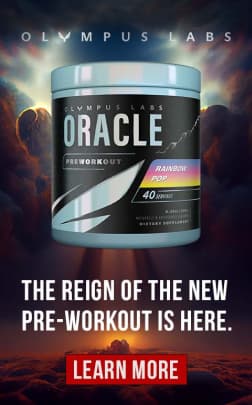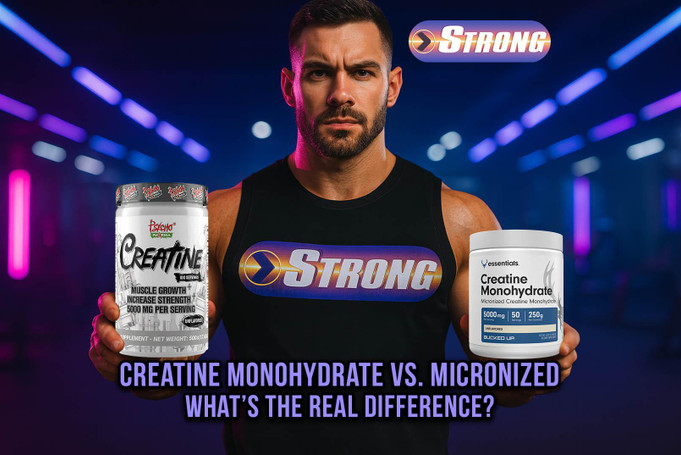Creatine Monohydrate vs. Micronized: What’s the Real Difference?
Posted by Leonard Shemtob on Jun 24, 2025
Discover which form of creatine best suits your fitness goals, digestive tract, and budget.
When it comes to supplements that deliver real performance results, creatine is one of the most researched and trusted options in sports nutrition. Whether you're a seasoned athlete, a bodybuilder, or simply trying to build lean muscle and improve endurance, chances are you've heard of creatine monohydrate. But what is micronized creatine? Is it better? Is it just marketing? Or is there a real difference that could impact your gains?
This guide breaks down the science, user experience, and performance implications of micronized creatine vs monohydrate so that you can choose the right formula for your body and budget.
Breaking Down the Basics of Creatine
Creatine is a naturally occurring compound found in your muscle cells. It's primarily used to help regenerate adenosine triphosphate (ATP), the body’s primary energy currency for short bursts of high-intensity activity, such as sprinting, lifting, and jumping. Supplementing with creatine increases your muscle's creatine phosphate stores, which may enhance strength, power output, and muscle volume.
What is Creatine Monohydrate?
Creatine monohydrate is the most studied and widely used form of creatine on the market. It’s composed of a creatine molecule bonded to a water molecule and has been proven to help increase muscle mass, strength, and exercise performance. It’s affordable, accessible, and trusted by researchers and athletes alike.
Key points:
- Composed of 88% creatine and 12% water
- Often comes in powder or capsule form
- Typically requires a "loading phase" for maximum effect
- Can sometimes cause minor bloating or stomach discomfort
Try it now: Creatine by Psycho Pharma (pure creatine monohydrate) | Creatine-X by Primaforce (creatine blend which includes monohydrate) | Six Point Creatine by Bucked Up (creatine blend which includes monohydrate)
What is Micronized Creatine?
Micronized creatine powder is essentially creatine monohydrate that has been processed into smaller particles. The idea behind micronization is that smaller particles will dissolve more easily in water, absorb more efficiently in the body, and reduce digestive issues for some users.
Key points:
- Identical molecule, but with a smaller particle size
- Aims to improve solubility and absorption
- Often easier on the stomach for some users
- Slightly more expensive due to extra processing
Explore micronized options: Creatine Monohydrate by Bucked Up (pure micronized creatine monohydrate) | Gorilla Mode Pre-Workout by Gorilla Mind (contains 5g micronized creatine)| Aftershock Critical Mass by Myogenix (mass gainer protein with micronized creatine)
Key Differences Between Micronized Creatine and Creatine Monohydrate
While both forms provide the same core benefits—enhanced strength, improved recovery, and muscle growth—the differences in particle size, solubility, and digestion can affect your experience depending on how your body responds to supplements.
Below is a breakdown of the primary distinctions between the two:
Effectiveness
Both micronized and monohydrate creatine deliver similar performance results. The creatine molecule is the same in both cases, so the muscle-building effects are equally reliable. However, some users find that micronized creatine may kick in a little quicker due to better solubility.
Solubility
This is one of the biggest differences. Micronized creatine powder mixes significantly better with water or other liquids. If you've ever had gritty residue at the bottom of your shaker, that’s likely monohydrate in its raw form.
Digestibility
Because of its finer particles and improved absorption, micronized creatine is generally easier on the stomach and less likely to cause bloating or gastrointestinal issues in sensitive users.
Form Factor
Creatine monohydrate typically comes in powder or capsule form. Micronized creatine is also a powder, but its ultra-fine texture gives it a smoother, cleaner mix. No clumps, no chalky feel.
Absorption Rate
Micronized creatine may be absorbed slightly faster due to its increased surface area. While this doesn't make a massive performance difference for most, it could matter if you're timing your supplement intake closely around workouts.
Creatine Monohydrate vs. Micronized Creatine: Comparison Table
| Feature: | Creatine Monohydrate | Micronized Creatine |
| Molecule: | Standard creatine monohydrate | Same molecule, smaller particles (micronized) |
| Solubility: | Moderate (may leave residue) | High (dissolves easily in water) |
| Digestibility: | May cause bloating or discomfort | Easier on stomach for many users |
| Absorption Rate: | Standard absorption | Slightly faster absorption |
| Form: | Powder or capsules | Fine powder |
| Price: | Usually more affordable | Slightly more expensive |
| Performance: | Proven effectiveness | Equally effective |
| User Preference: | Budget-conscious, traditional users | Users with sensitive stomachs or solubility needs |
Advantages and Disadvantages of Creatine Monohydrate
Pros
- Backed by extensive research: Over 1,000 studies support its safety and effectiveness.
- Cost-effective: One of the most affordable sports supplements available.
- Widely available: Easy to find in virtually any supplement store.
- Proven track record: Trusted by athletes, bodybuilders, and trainers for decades.
- Stack-friendly: Works well with pre-workouts, BCAAs, and protein powders.
Cons
- May cause bloating: Some users report water retention and minor GI discomfort.
- Gritty texture: Doesn’t always dissolve well, leaving a chalky residue in your shaker.
- Requires loading phase: For full saturation, many protocols call for a 5- to 7-day loading phase.
Advantages and Disadvantages of Micronized Creatine
Pros
- Better solubility: Dissolves more easily in water or shakes for a smoother mix.
- Gentler on digestion: Less likely to cause bloating or stomach upset.
- No loading phase needed: Some users report quicker effects due to improved absorption.
- User-friendly: Great for those who dislike gritty textures or clumpy powders.
Cons
- Slightly more expensive: Extra processing adds to the cost.
- Not as widely researched: Though the base molecule is the same, micronization-specific studies are limited.
- Some find effects similar to monohydrate: Benefits may not justify the price for everyone.
Choosing the Best Creatine for Your Body and Budget
When it comes to picking the best form of creatine, it all comes down to your personal preferences, digestive sensitivity, training style, and budget.
Factor to Consider:
- Budget-conscious? Stick with creatine monohydrate. It offers the most bang for your buck and delivers proven results.
- Sensitive stomach or gastrointestinal issues? Go for micronized creatine — it dissolves better and is often easier to digest.
- Training at a high level or in-season? Faster absorption might help with recovery. In that case, micronized creatine could be worth the slight upgrade.
- Just starting out? Creatine monohydrate is more than sufficient for beginners looking to build size and strength.
Quick Comparison:
| You Should Choose... | If You... |
| Monohydrate | Want proven results at a lower cost |
| Micronized | Prefer faster mixing and gentler digestion |
Micronized or Monohydrate? Pick the One That Fits Your Goals
In the debate of micronized creatine vs monohydrate, both types of creatine provide science-backed benefits for muscle growth, strength, and performance. Whether you choose creatine monohydrate for its affordability and legacy or micronized creatine for its mixability and digestive ease, you’re investing in a supplement with a strong track record of success.
If you're just starting out or want to stick to the fundamentals, creatine monohydrate is a solid choice. On the other hand, if you’re looking for improved solubility and fewer digestive issues, micronized creatine powder might be worth the small upgrade.
Ready to Power Up Your Training:
No matter which creatine is best suited to your preferences, both forms deliver proven results—just find the one that fits your body and your routine.
Explore Strong Supplement’s full lineup of premium creatine options to match your performance goals and budget.
Written and Sponsored by Leonard Shemtob
Leonard Shemtob is President of Strong Supplements and a published author. Leonard has been in the supplement space for over 20 years, specializing in fitness supplements and nutrition. Leonard appears on many podcasts, written over 100 articles about supplements and has studied nutrition, supplementation and bodybuilding.
Leonard's articles have been published in many top publications around the web. Leonard enjoys weight training, playing basketball and yoga, and also enjoys hiking. In his free time he studies and works on improving himself. For more detailed information, visit his official blog.


